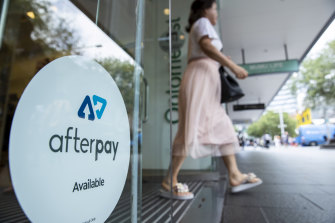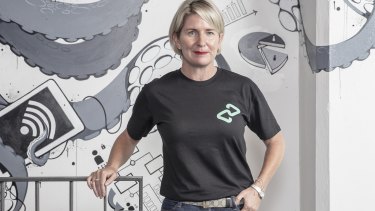Tech-savvy, disloyal and debt-shy: Banking’s battle for the young heats up
The financial habits of 26-year-old Murali Ramesh are a perfect illustration of how younger people are shaking up the lucrative world of Australian retail banking and challenging the big four’s stranglehold on the market.
The conference producer, who lives in the Sydney suburb of Homebush, has bank accounts with the Commonwealth Bank, Bendigo Bank-backed Up and is looking to open a third with 86 400, recently bought by National Australia Bank.
26 year-old Murali Ramesh: “I’m open to trying new things and seeing how they work.”Credit:Nick Moir
Ramesh uses the foreign exchange fintech Wise (formerly TransferWise) for sending money to family in India and has an account with Afterpay, though he hasn’t used it yet. He doesn’t have a credit card and has doubts about committing to a 30-year home loan. He feels no particular loyalty to individual banks, and would happily try other digital banks if they had compelling features.
“I’m open to trying new things and seeing how they work,” says Ramesh, who produces financial services conferences.
“In an ideal world, it would be good to have one bank that does it all. But from my perspective I don’t have a problem with having multiple bank accounts.”
Similar behaviour from his fellow millennials and members of the younger Generation Z is driving a battle for the young in banking, which is one of the key forces behind the disruption sweeping the financial sector.
Bankers describe a generation of tech-savvy customers who do their banking on smartphones, expect slick digital features and are not particularly loyal to established brands.
This has opened the door to an array of rivals such as Afterpay, Zip and others to attack a critical market for the banks. For the big four, however, it raises major strategic challenges as they try to protect their dominant position and hang on to customers like Ramesh.
The $27 billion sharemarket valuation of Afterpay is proof that selling financial services to younger people can be very big business. The Sydney-based fintech has openly targeted younger customers for its buy now, pay later (BNPL) service, which allows people to buy goods upfront and repay the money in interest-free instalments.
Millennials overtaking the boomers
Millennials, defined as those born between 1981 and 1996, already make up about a third of all consumer spending, according to Afterpay-commissioned research by AlphaBeta. Their share of the market is tipped to grow even larger in years to come.
“I think the millennials by 2025 will be much bigger than baby boomers, and if you include the subsequent generations they’ll be at least 20 per cent bigger than baby boomers,” says director of AlphaBeta Andrew Charlton, who consults to Afterpay.
But the sky-high valuation investors have given Afterpay reflects more than a bet on the growing economic weight of millennials.
Investors have given Afterpay sky high valuations.Credit:Louie Douvis
It also reflects a belief that Afterpay’s profits will swell as it moves from BNPL into the lucrative world of banking, which it is doing soon through a partnership with Westpac. This is just one example of how fintechs are using their appeal with the young as a launching pad to attack the major banks’ massive businesses.
Younger customers have always been sought-after, of course. While they are not always profitable initially for banks, many grow up to become highly-lucrative mortgage customers. Jefferies analyst Brian Johnson refers to them as banks’ “feedstock.”
In the past, however, there was less opportunity for rivals to pinch these customers, who were often signed up to the bank by their parents, or joined through a school banking scheme such as CBA’s Dollarmites program.
These days, deep-seated changes in technology and customer behaviour mean banks must work much harder to hold onto their young clients.
For one, younger people feel less loyalty to banks. PwC’s banking and capital markets leader Sam Garland points to an upcoming survey from PwC that found 27 per cent of Gen Y and 21 per cent of Gen Z are open to switching their main banking relationship in the next year.
“That compares to only 14 per cent for the population as a whole. So it tells you why targeting these relationships when people are young is important to both individual fintechs, but also the larger bank,” Garland says.
Gen Y and Gen Z’s openness to technology also stands out. A global survey by KPMG found that globally, 41 per cent of Generation Z customers would rather lose their wallet than their smartphone. “The opportunity and threat for banks not taking this segment seriously is substantial,” says KPMG’s national sector leader for banking, Ian Pollari.
COVID-19 has sped up these trends, causing the shift to digital commerce and banking to accelerate markedly.
For banks, the upshot is a wave of tech-savvy, disloyal consumers who are much more open to having accounts with multiple banks and fintechs.
Chief executive of NAB-owned UBank, Philippa Watson, says that when banking is done via a smartphone, such “multi-banking” is “perfectly convenient.”
“I think that the big change has been that younger people in particular are very happy to have 100 per cent of their banking relationship with a smartphone, and never go into a branch at all,” Watson says.
Yet another key change is that younger generations are more debt-shy, especially when it comes to credit cards. As BNPL has taken off with the young, the number of personal credit card accounts has fallen by almost 2 million in the last two years, RateCity says.
Like some other neobanks, youth-focused bank Up, for example, has steered clear of offering a credit card to its 375,000 customers, about half of whom are under 25. Up’s head of product Anson Parker says doing so would go against its fundamental pitch to help customers get a better handle on managing their money.
“They [credit cards] are just too easy for people to sort of switch off and disconnect and just tap that plastic card and not have to think about what that means,” he says. “That’s just a typical thing we see in young people.”
Fintechs eye bigger share
The early effects of younger people’s shifting financial behaviour are already visible. Perhaps the most striking consequence has been the surging popularity of buy now, pay later businesses, led by Afterpay and Zip.
Having signed up millions of typically younger Australians, these leading BNPL players are now working on how to make the most of this hefty customer base. All indications are that the fintechs will launch new products that move further onto banks’ turf.
Afterpay, for example, is set to launch its own branded banking product soon after a deal to use Westpac’s licence and infrastructure.
Afterpay’s executive running the banking push, Lee Hatton, says the product will be aimed at female Generation Z customers in particular, and it will focus on “key spending and savings needs”. In the longer term, she says its vision is “to help solve financial empowerment for the entire next generation.”
Afterpay’s Lee Hatton says the BNPL firm is trying to offer financial empowerment to the next generation.Credit:Louie Douvis
Zip co-founder Peter Gray says the company is also thinking about how to expand its “digital wallet” and offer more financial services to its 2.5 million mainly young clients. “For this younger cohort, what are the items they want on the menu for their future financial diet? What options would they be interested in? Is it things like buying and selling shares or even buying and selling crypto?” Gray says.
Zip would also look at some sort of “high-coupon” savings product, he says, rather than a traditional bank account.
This wave of fintech based competition is a real, albeit long-term, strategic challenge to the major banks’ dominance. In response, the big four have been forced to make some big decisions about how they compete for younger customers.
No major bank is more exposed to this trend than CBA, which is expected to touch on these themes at an investor briefing on technology next week. Survey data cited by CBA shows more than 40 per cent of people aged between 18 and 34 regard CBA (including Bankwest) as their main financial institution.
So it’s perhaps unsurprising that CBA has been the most active in competing for the young, through heavy digital investment, including in its app , and move to take on Afterpay head-to-head through its own buy now, pay later product.
Jefferies analyst Brian Johnson, who has “buy” rating and a $106.50 price target on CBA shares, says he believes the bank is the most active of the big four in fighting with the fintechs.
“I don’t see ANZ, NAB or Westpac really doing much. I do see a battle between CBA and all the new players,” Johnson says.
‘Younger people … are very happy to have 100 per cent of their banking relationship with a smartphone, and never go into a branch at all.’
NAB has said it aims to sign up more younger customers through its purchase of 86 400, which is being integrated with its digital offshoot UBank. UBank CEO’s Watson says the lender, which started out as a savings bank, has traditionally not been as active among 18 to 25 year-olds and hopes to address this, including by focusing on payments and budgeting tools.
But aside from a no-interest credit card, NAB has not suggested it is about to unveil its own BNPL product to compete directly with Afterpay. And at this month’s half-yearly results, neither ANZ Bank nor Westpac appeared to be in any hurry to join the BNPL stampede, either.
Westpac’s chief Peter King conceded young people valued the simplicity of BNPL, but he thought the bank had time to respond as needed. “We’ve got a while. Buy now, pay later’s certainly getting a lot of interest, its share price is obviously one of the things that people talk about. But I’m still confident in the core offering of the bank,” King said at the lender’s results earlier this month.
ANZ chief Shayne Elliott also said he thought the bank would participate in payments innovation, but he was not losing any sleep over the buy now, pay later threat. “I don’t want to sound like a dinosaur, but I think we’re a long way from proving the proposition that because I bought a pair of jeans yesterday with buy now, pay later I’m therefore the future homeowner customer who’s going to use that same provider to buy my home or run my business,” Elliott said at ANZ’s results.
An even more fundamental question, however, is whether the younger consumers flocking to Afterpay will even have the appetite for taking on the huge mortgages of earlier generations.
Sure, the ultra-low level of interest rates means debt is more affordable. But younger people also face financial challenges their parents did not. They have experienced slower wage growth than earlier generations, housing costs are far higher, and they have been burdened with more debt from university, so it is hardly surprising some are more debt-shy.
This hesitance towards taking out a big mortgage is shared by 26-year-old Ramesh. He says he has been thinking about investments and building wealth, including some dabbling in bitcoin and shares. But he is not sure that taking out a large 30-year loan for a property is the answer.
“I don’t want to be paying a mortgage for the next 30 years. How do I find a solution for that?” he says. “I’m working it out.”
Business Briefing
Start the day with major stories, exclusive coverage and expert opinion from our leading business journalists delivered to your inbox. Sign up here.
Most Viewed in Business
From our partners
Source: Read Full Article





